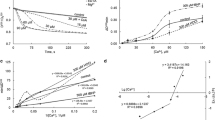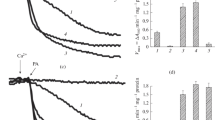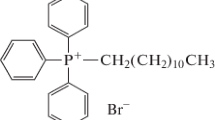Abstract
Addition of 5 μM copper to rat kidney mitochondria enhances the effect of carboxyatractyloside and oleate on pore opening, in a cyclosporin A-sensitive fashion. The effects of the pair copper-carboxyatractyloside were observed on matrix Ca2+ efflux, mitochondrial swelling and on the transmembrane electric gradient. The effect of Cu2+ emphasizes the importance of membrane thiol groups located, probably, in the ADP/ATP translocase (ANT), on permeability transition. It was also found that Cu2+ does not block the fluorescent label of ANT by eosin 5-maleimide, but abolishes the inhibition by CAT on the labeling. This suggests that the binding of Cu2+ to cysteine residues of ANT promotes a conformational change in the carrier, strengthening the effect of CAT and oleate on membrane leakage.
Similar content being viewed by others
References
Igbavboa U, Zwizinski CW, Pfeiffer DR: Release of mitochondrial matrix proteins through a Ca2+-requiring, cyclosporin-sensitive pathway. Biochem Biophys Res Commun 161: 619-625, 1989
Gunter TE, Pfeiffer DR: Mechanisms by which mitochondria transport calcium. Am J Physiol 258: C755-C786, 1990
Zoratti M, Szabó I: The mitochondrial permeability transition. Biochim Biophys Acta 1241: 139-176, 1995
LeQuoc K, LeQuoc D: Involvement of the ADP/ATP carrier in calcium induced perturbations of the mitochondrial inner membrane permeability: Importance of the orientation of the nucleotide binding site. Arch Biochem Biophys 265: 249-257, 1988
Chávez E, Moreno-Sánchez R, Zazueta C, Reyes-Vivas H, Arteaga D: Intramitochondrial K+ as activator of carboxyatractyloside-induced Ca2+ release. Biochim Biophys Acta 1070: 461-466, 1991
Brustovetsky NN, Egorova MV, Gnutov DYu, Mokhova EN, Skulachev VP: Cyclosporin A suppression of uncoupling in liver mitochondria of ground squirrel during arousal from hibernation. FEBS Lett 315: 233-236, 1993
Halestrap AP, Davidson AM: Inhibition of Ca2+-induced largeamplitude swelling of liver and heart mitochondria by cyclosporin is probably caused by the inhibitor binding to mitochondrial-matrix peptidyl-prolyl cis-trans isomerase and preventing it interacting with the adenine nucleotide translocase. Biochem J 268: 153-160, 1990
Novgorodov SA, Gudz TI, Kushnareva YE, Zorov DB, Kudrjashov YB: Effect of ADP/ATP antiporter conformational state on the suppression of the non-specific permeability of the inner mitochondrial membrane. FEBS, Lett 277: 123-126, 1990
Halestrap AP, Woodfield KY, Connern CP: Oxidative stress, thiol reagents, and membrane potential modulate the mitochondrial permeability transition by affecting nucleotide binding the adenine nucleotide translocase. J Biol Chem 272: 3346-3354, 1997
Schönfeld P, Bohnensack R: Fatty acid-promoted mitochondrial permeability transition by membrane depolarization and binding to the ADP/ATP carrier. FEBS Lett 420: 167-170, 1997
Chávez E, Franco M, Reyes-Vivas H, Zazueta C, Ramírez J, Carrillo R: Hypothyroidism renders liver mitochondria resistant to the opening of membrane permeability transition pore. Biochim Biophys Acta 1407: 243-248, 1998
Broekemeier KM, Pfeiffer DR: Inhibition of the mitochondrial permeability transition by cyclosporin A during long time frame experiments: Relationship between pore opening and the activity of mitochondrial phospholipases. Biochemistry 34: 16440-16449, 1995
Szabó I, Zoratti M: The giant mitochondrial channel of the inner mitochondrial membrane is inhibited by cyclosporin A. J Biol Chem 266: 3376-3379, 1991
Costantini P, Chernyak BV, Petronilli V, Bernardi P: Modulation of the mitochondrial permeability transition pore by pyridine nucleotides and dithiol oxidation at two separate sites. J Biol Chem 271: 6746-6751, 1996
Klingenberg M, Nelson DR: Structure-function relationships of the ADP/ATP carrier. Biochim Biophys Acta 1187: 241-244, 1994
Aquila H, Klingenberg M: The reactivity of–SH groups in the ADP/ATP carrier isolated from beef heart mitochondria. Eur J Biochem 122: 141-145, 1982
Scarpa A, Brinley FJ, Tiffert T, Dubyak GR: Metallochromic indicators of ionized calcium. Ann NY Acad Sci 307: 86-112, 1978
Akerman KEO, Wikström MFK: Safranine as a probe of the mitochondrial membrane potential. FEBS Lett 68: 191-197, 1976
Lowry OH, Rosebrough NJ, Farr AL, Randall RJ: Protein measurement with the folin phenol reagent. J Biol Chem 193: 262-275, 1951
Majima E, Koike H, Hong YM, Shinohara Y, Terada H: Characterization of cysteine residues of mitochondrial ADP/ATP carrier with the SH-reagents eosin 5-maleimide and N-ethylmaleimide. J Biol Chem 268: 22181-22187, 1993
Zazueta C, Reyes-Vivas H, Zafra G, Sánchez CA, Vera G, Chávez E: Mitochondrial permeability transition as induced by cross-linking of the adenine nucleotide translocase. Int J Biochem Cell Biol 30: 517-522, 1998
Novgorodov SA, Gudz TI, Brierley GP, Pfeiffer DR: Magnesium ion modulates the sensitivity of mitochondrial permeability transition pore to cyclosporin A and ADP. Arch Biochem Biophys 311: 219-228, 1994
Castiti R, Vercesi AE: The participation of pyridine nucleotides redox state and react oxygen in the fatty acid-induced permeability transition in rat mitochondria. FEBS Lett 464: 97-101, 1999
Skulachev V P: Uncoupling: New approaches to an old problem of bioenergetics. Biochim Biophys Acta 1363: 100-124, 1998
Wieckowski MR, Wojtczak L: Fatty acid-induced uncoupling of oxidative phosphorylation is partly due to opening of the mitochondrial permeability transition pore. FEBS Lett 423: 339-342, 1998
Chávez E, Zazueta C, García N: Carboxyatractyloside increases the effect of oleate on mitochondrial permeability transition. FEBS Lett 445: 189-191, 1999
Garlid KD, Sun X, Pauceck P, Woldegiorgis G: Mitochondrial cation transport systems. Meth Enzymol 260: 331-348, 1995
Petronilli V, Costantini P, Scorrano L, Colonna R, Passamonti S, Bernardi P: The voltage sensor of the mitochondrial permeability transition pore is tuned by the oxidation-reduction state of vicinal thiols. Increase of the gating potential by oxidants and its reversal by reducing agents. J Biol Chem 269: 166638-16642, 1994
Fagian M, Pereira-da-Silva L, Martins IS, Vercesi AE: Membrane protein thiol cross-linking associated with the permeabilization of the inner membrane by Ca2+ plus prooxidants. J Biol Chem 265: 19955-19960, 1990
Schweizer M, Durrer P, Richter C: Phenylarsine oxide stimulates pyridine nucleotide-linked Ca2+ release from rat liver mitochondria. Biochem Pharm 48: 967-973, 1994
Majima E, Ikawa K, Takeda M, Hashimoto M, Shinohara Y, Terada H: Translocation of loops regulates transport activity of mitochondrial ADP/ATP carrier deduced from formation of a specific intermolecular disulfide bridge catalyzed by copper-o-phenanthroline. J Biol Chem 270: 29548-29554, 1995
Müller M, Krebs JJR, Cherry RJ, Kawato S: Selective labeling and rotational diffusion of the ADP/ATP translocator in the mitochondrial inner membrane. J Biol Chem 257: 1117-1120, 1982
Rück A, Dolder M, Wallimann T, Brdiezka D: Reconstituted adenine nucleotide translocase forms a channel for small molecules comparable to mitochondrial transition pore. FEBS Lett 426: 97-101, 1998
Crompton M: The mitochondrial permeability transition pore and its role in cell death. Biochem J 341: 233-249, 1999
Beavis AD, Lu Y, Garlid KD: On the regulation of K+ uniport in intact mitochondria by adenine nucleotides and nucleotide analogs. J Biol Chem 268: 997-1004, 1993
Author information
Authors and Affiliations
Rights and permissions
About this article
Cite this article
García, N., Zazueta, C., Carrillo, R. et al. Copper sensitizes the mitochondrial permeability transition to carboxyatractyloside and oleate. Mol Cell Biochem 209, 119–123 (2000). https://doi.org/10.1023/A:1007151511817
Issue Date:
DOI: https://doi.org/10.1023/A:1007151511817




